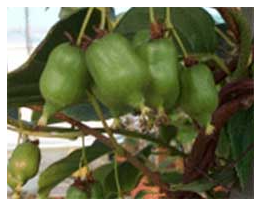Grow Kiwi Fruit
 No matter what climate zone you live in, it's a sure bet you can grow kiwi. A beautiful vine, kiwis sport fuzzy leaves, deep green smooth leaves, toothed and usually with some shade of red stems. A fast grower that even from seed can produce fruit in just a few years.
No matter what climate zone you live in, it's a sure bet you can grow kiwi. A beautiful vine, kiwis sport fuzzy leaves, deep green smooth leaves, toothed and usually with some shade of red stems. A fast grower that even from seed can produce fruit in just a few years.
Kiwi, or actinidia, usually need a make and female plant in order to pollinate the flowers and then produce fruit. For this reason, it is imperative that you grow several to make sure you have each sex of plant.
The seeds of kiwi are small, black and sometimes difficult to coax up. Here in Florida, I start mine like most other seeds and cuttings, in September; to give the plants the benefit of cooler weather while emerging and starting out, instead of the hot, sultry Florida summers that could cause too much stress and kill the young plants.
A cultivar that is quite popular in Australia and Europe is the grape sized kiwi "Assai." If you have time, starting it from seed can be done, but it will take about 4 to 5 years before it reaches maturity and begins to flower for you. This cultivar is great for cooler climates, being able to withstand the Siberian winters, and is grown there. European markets sell it in small half pints, like you see our blueberries, blackberries and raspberries presented, and can easily sell for about 7.00 per half pint. All the more reason for you to get on the bandwagon and grow some kiwi of your own!
Start with a couple of flats, and use your own Premade Seedling Mixture. Soak as much as you will need the night before, as this mix has a high peat ratio. In the morning, press it lightly into the flats, making sure to get the corners well, so no seeds fall into them. Then spread the tiny seeds evenly and cover with a light dutsing of ground peat. Not too much, we are't trying to deprive these seeds of light, just give the root end something to grab into when it germinates.
Keep them moist with a good misting bottle that you have filled with rainwater or tap water that has been let set overnight. If you have viable seeds, the seedlings should appear within 30 to 60 days, depending upon the cultivar and temperatures they are exposed to. Of course, if you are in a colder climate, you can start the seeds indoors over the winter, just make sure they have appropriate lighting to make it through until spring when you can put them out.
After they are up and about 3 to 4 weeks old, carefully prick each seedling that you think is strong enough to transfer and place in separate 2 inch diameter, deep pots that have been prefilled with potting soil. Begin lightly fertilizing them with a half strength fertilizer, and make sure they get at least 8 hours of sunlight a day. In another 2 months, they should be large enough to need a bamboo stick support. Actinidia have deep roots, so make sure when transferring to larger pots that they are tall, not shallow.
Keep upping the pot sizes by 2 inches across as the roots begin to peek out the bottoms. When the plant has grown slightly rootbound in a 6 inch pot, they are big enough to transfer out to their permanent place in the landscape. Because these plants do become enormous, use a very strong trellis or chainlink fence as a support system. These vines do not pocess tendrils, so you will need to initially train them onto the support.
Another important thing about placing them out, is to keep perennial weeds away from the root space (about 18 inches across) for the first couple of years. These weeds will compete with the roots of the tender new plants, and reduce the nutrients that would otherwise be used by your fruit plants. After that time, the plants should have reached a size enough that they will create enough shade that weeding will go down to a minimum.
Fertilize each plant twice a year with a large variety Fruit and Nut spike that you have driven into the soil near the root ball. Keep them well watered for the first couple of years, by watering every other day until your rainy season kicks in. Do not allow them to completely dry out. After that, the roots should have found their own water source and watering will only be needed in case of drought conditions.
Tags: grow kiwi, grow actinidia, kiwi vines, actinidia vines, kiwi, actinidia,


